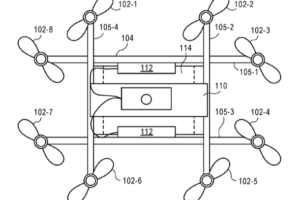 Amazon‘s drone delivery project has resulted in the filing of dozens of patents. We’ve seen ideas for drones hitching rides on trucks, a “welcome mat” style landing pad, folding wing designs, and even flying warehouses. A new patent application, filed in February but published yesterday, describes a plan for protecting people and objects from drone propellers: “Virtual Safety Shrouds.”
Amazon‘s drone delivery project has resulted in the filing of dozens of patents. We’ve seen ideas for drones hitching rides on trucks, a “welcome mat” style landing pad, folding wing designs, and even flying warehouses. A new patent application, filed in February but published yesterday, describes a plan for protecting people and objects from drone propellers: “Virtual Safety Shrouds.”
The application, which lists Amazon’s drone delivery guru Gur Kimchi as one of the three inventors, describes an idea for shutting down a propeller as it detects a near collision – while revving up the remaining propellers in order to keep the drone in flight.
“… When an approaching object is detected by an object detection component, a safety profile may be executed to reduce or avoid any potential harm to the object and/or the aerial vehicle,” says the abstract. “For example, if the object is detected entering a safety perimeter of the aerial vehicle, the rotation of a propeller closest to the object may be stopped to avoid harming the object and rotations of remaining propellers may be modified to maintain control and flight of the aerial vehicle.”
The system is designed to address concerns that drone delivery vehicles could collide with pets or children, causing injury. And unlike some of the more far-fetched ideas that some of drone technology patents propose, this seems to make a lot of sense. Create a drone with redundancies built in, and then sound an alarm and cut the power to any propeller that seems about to collide with something.
“By eliminating or reducing harmful contacts between a propeller of an AAV and an object, AAVs may be operated in areas with unknown or changing surroundings without injuring the AAV or objects (e.g., humans, pets, or other animals),” reads the application. “For example, an AAV may be configured to deliver a payload that contains an item ordered from an e-commerce website to a customer specified location (e.g., a backyard of customer’s home). As the AAV is preparing to land at the customer specified location to deliver the payload, it may monitor for objects (e.g., pets, humans) approaching the AAV and quickly respond to prevent the object from becoming harmed. For example, if a dog (object) approaches the AAV as the AAV is landing and the dog enters the safety perimeter of one of the propellers of the AAV, a safety profile is automatically performed so that the dog is not harmed by the propeller.”
“As discussed below, the safety profile may include stopping the propeller, stopping other propellers of the AAV, maneuvering the AAV away from the object, landing the AAV, emitting an audible tone, altering an orientation of the blades of the propeller, etc.”
 It’s easy to see this type of technology, if successful in its implementation, being adopted across a broad range of drone hardware. If so, it’s an argument that pursuing drone delivery could have broader benefits for the industry – a more powerful example than, perhaps, the “drone birdhouse” docking stations atop streetlights proposed previously.
It’s easy to see this type of technology, if successful in its implementation, being adopted across a broad range of drone hardware. If so, it’s an argument that pursuing drone delivery could have broader benefits for the industry – a more powerful example than, perhaps, the “drone birdhouse” docking stations atop streetlights proposed previously.

Miriam McNabb is the Editor-in-Chief of DRONELIFE and CEO of JobForDrones, a professional drone services marketplace, and a fascinated observer of the emerging drone industry and the regulatory environment for drones. Miriam has penned over 3,000 articles focused on the commercial drone space and is an international speaker and recognized figure in the industry. Miriam has a degree from the University of Chicago and over 20 years of experience in high tech sales and marketing for new technologies.
For drone industry consulting or writing, Email Miriam.
TWITTER:@spaldingbarker
Subscribe to DroneLife here.







[…] noticed much more patents: a digital drone security shroud, a folding wing drone design, drone supply infrastructure, the thought of “launching” packages […]